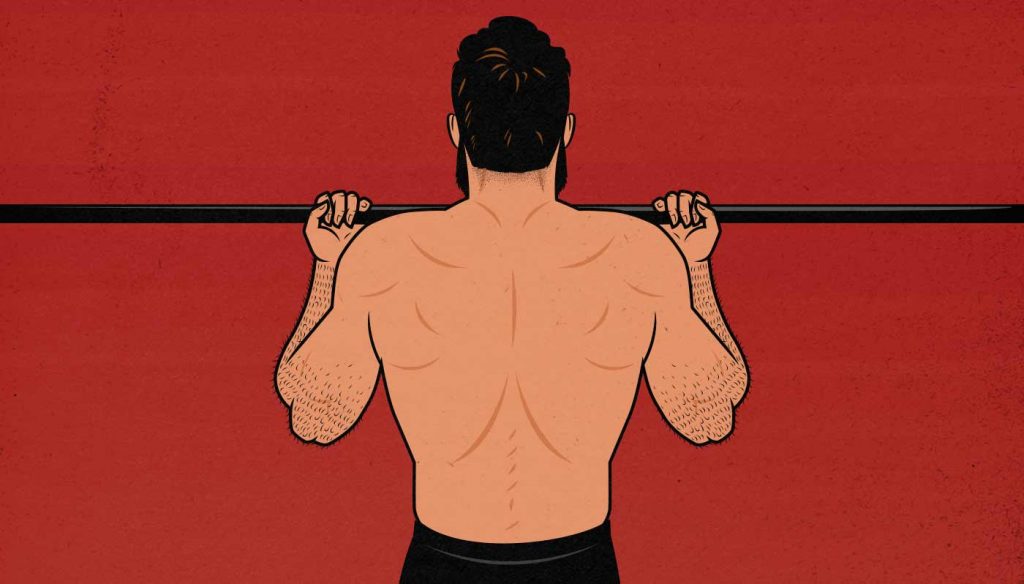
The Chin-Up Hypertrophy Guide
Chin-ups are a great lift for your upper back, abs, and grip strength. They’re even a great lift great for improving your cardiovascular fitness. What they’re most famous for, though, is building absolutely killer biceps.
In fact, the only other lift that’s as good for bulking up our biceps is the biceps curl. But given that curls are a smaller single-joint movement, they’re better thought of as an assistance lift to the chin-up anyway.
The chin-up is one of our Big 5 bulking lifts, and in this article we’re going to go over the best strategies for integrating it into your bulking routine, getting the most muscle mass and strength out of it as possible.
In this article, we’ll cover:
- How to bulk up your arms, back, and abs with the chin-up.
- Whether you should use a neutral grip, overhand grip, or underhand grip as your main chin-up variation.
- How to assess your weaknesses and then fix them.
- The best assistance lifts for improving your chin-up strength.
- How to use accessory lifts, such as biceps curls and rows.
What is a Chin-Up?
The chin-up is a compound exercise that works our upper backs and biceps. It’s done by hanging from a bar with an underhand grip and then pulling your chin over the bar, hence its name.
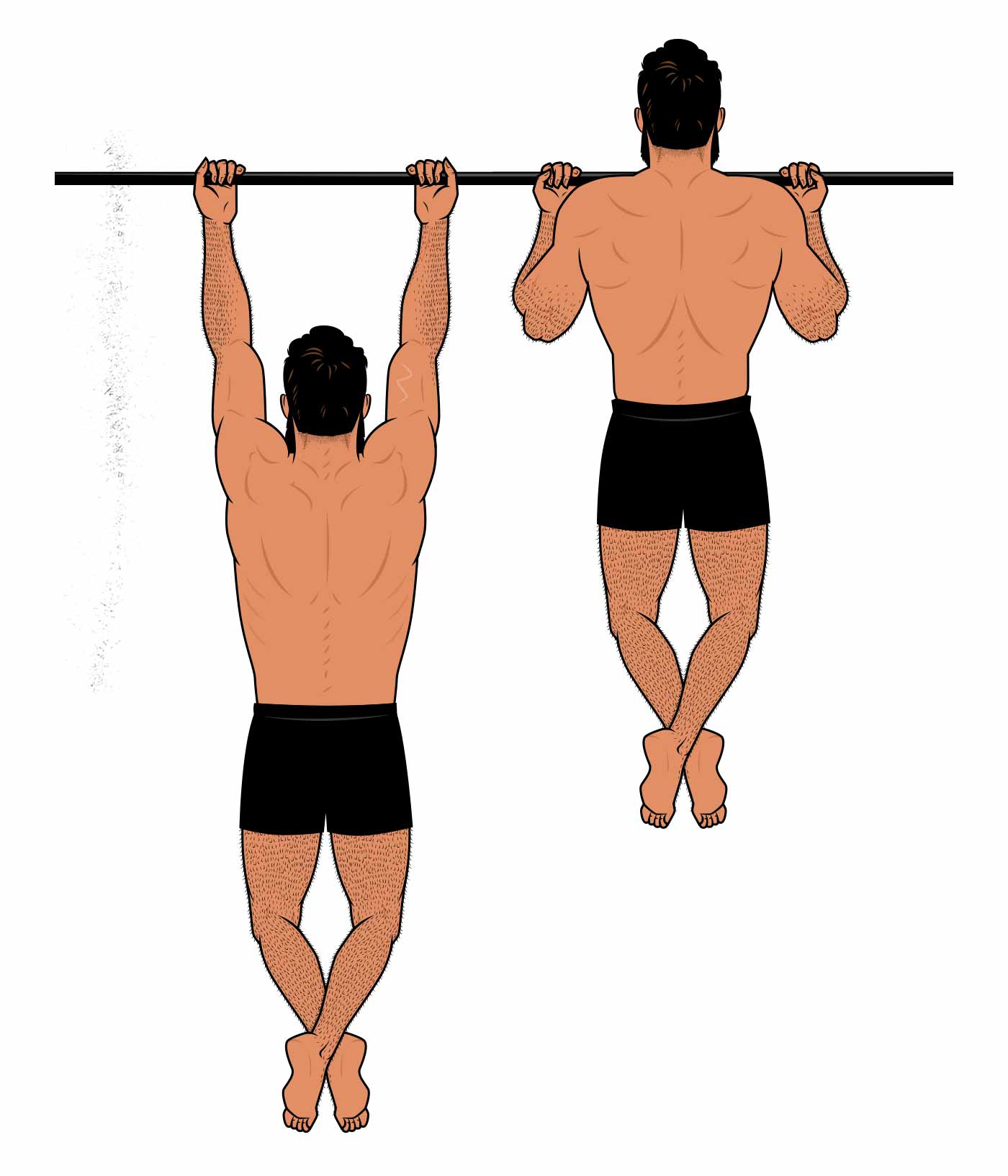
The word “chin-up” is often used interchangeably with the word “pull-up,” but most experts use the different names to refer to two different lifts. The chin-up is done with an underhand grip, as shown above, whereas the pull-up is done with an overhand grip. We’ll talk about the differences in a minute, but the chin-up is a big compound exercise, whereas the pull-up is a much smaller lift.
With that said, you can do chin-up in a variety of different ways. You can use an angled bar or gymnastics rings to make them easier on your elbow joints. And you can do them with your bodyweight for as many reps as possible, or you can load them with weights and do heavy sets.
How to Do Chin-Ups
Chin-ups are a fairly simple lift. We grip the bar slightly wider than shoulder width, then we pull ourselves up. There’s a bit more nuance to it. For instance, it helps to brace your abs so that your torso doesn’t wobble around. But most people can learn the technique quite easily.
Here’s a tutorial video of Marco teaching the chin-up:
The trick with chin-up is that you need to be quite strong to do them, and the more you weigh, the stronger you’ll need to be. If you can’t do 2–3 full chin-ups yet, you can do lowered chin-ups instead, jumping up to the bar or using a stool, and then lowering yourself back down. You’ll still develop the same muscles and get the same benefits. (And we have more beginner strategies below.)
What Muscles Do Chin-Ups Work?
Main Muscles Worked
As covered in the last section, chin-ups are incredible for bulking up your back and biceps. But chin-ups will also work your other forearm flexors, both in your upper arms (brachialis) and forearms (brachioradialis). And they’ll work your grip, your upper chest, your rear delts, and even your abs. In fact, they’re one of the very best ab exercises, easily beating out crunches and sit-ups (reference).
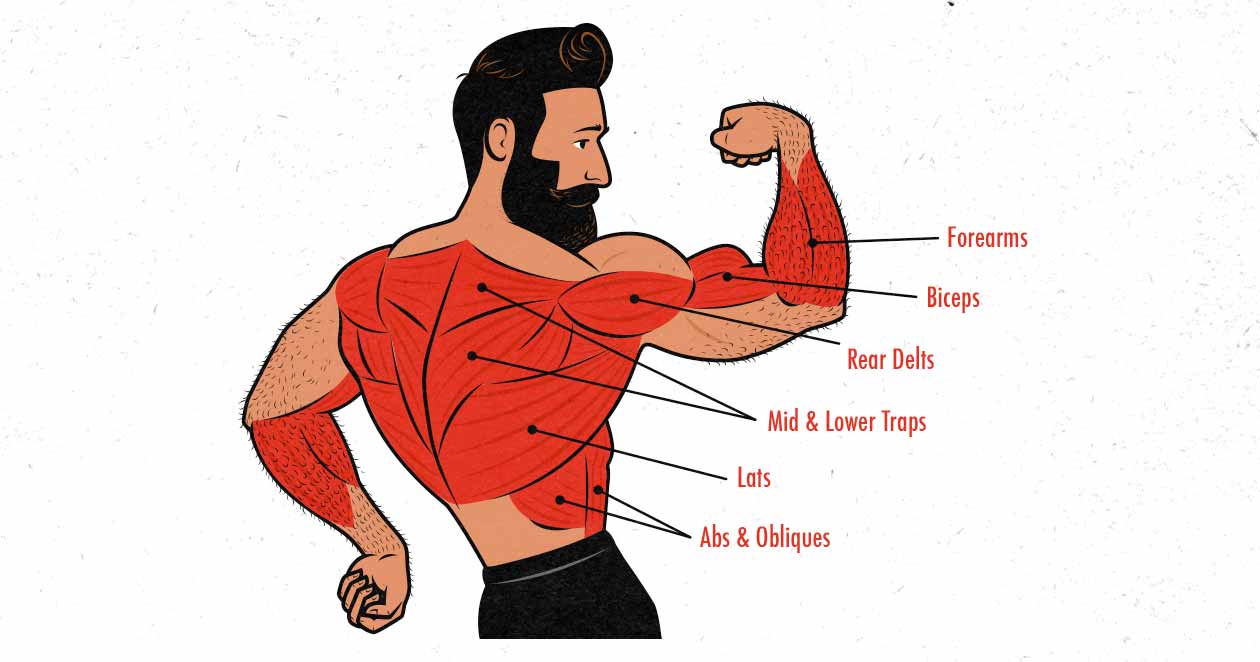
This makes chin-ups one of the biggest compound lifts, and certainly the biggest lift for your upper body. But even so, chin-ups still aren’t a complete back exercise. After all, they won’t grow your upper traps or spinal erectors, both of which are big muscles, important for general strength, and contribute quite a lot to our appearance. That’s where the deadlift and barbell row come in, hitting all of the muscles that the chin-up misses.
With chin-ups and deadlifts, you’ll be able to build a truly fearsome back. Add in some smart assistance and accessory lifts, such as rows and curls, and men will cower before you. Or, rather, cower behind you.
Do Chin-Ups Train the Triceps?
Yes, chin-ups work the triceps. You might have noticed that your triceps get sore from doing chin-ups, and that’s totally normal. Chin-ups work the long head of the triceps similar to how a pullover works the long head of the triceps. But that doesn’t necessarily mean that the chin-up will work your triceps hard enough to build much muscle back there.
The long head of the triceps is a biarticular muscle that crosses both the elbow and the shoulder joint. It can extend the elbows, as in a skull crusher, and it can also extend the shoulders, as in a pullover. This means that when you flex our triceps during chin-ups, they pull your elbows back towards your torso, which helps, but they also open your arms, which hurts. As a result, we can’t fully engage our triceps for fear of interfering with our biceps. So the long head of your triceps will work, but it might not work enough to stimulate much muscle growth.
If you want to bulk up the long head of your triceps, chin-ups can certainly help, but skull crushers and overhead extensions are better bets. On the other hand, if you’ve already bulked your triceps up, chin-ups will be more than enough to maintain their size, and maybe even gain a bit of size.
- If you’re intentionally trying to build bigger triceps, it can help to include triceps isolation lifts like skull crushers and overhead extensions.
- If you’re focusing on other areas or building a minimalist workout routine, chin-ups and pressing movements are more than enough to maintain or make slow progress on your triceps.
The Best Chin-Up Variations
There are a few different ways to grip the bar when doing chin-ups. We’ve already covered the difference between chin-ups (using an underhand or neutral grip) and pull-ups (using an overhand grip). And we’ve already covered why chin-ups tend to be better for building muscle. They have a larger range of motion and do a better job of engaging our biceps.
But there are a few different variations of the chin-up, each with their own pros and cons.
Underhand Chin-Ups
The traditional way of doing chin-ups is to use a straight bar, and grip it with a shoulder-width underhand grip. This variation has a huge range of motion and does a good job of bulking up both our biceps and back muscles.
What’s interesting about using this underhand grip is that it puts a greater stretch on our biceps, improving muscle growth. However, this comes at the cost of our other elbow flexors (brachialis and brachioradialis) having a harder time contributing to the lift.
Neutral-Grip Chin-Ups
Neutral grip chin-ups are done with our palms facing one another. They require a special bar, but there are some notable advantages to them:
- All of our elbow flexors (biceps, brachialis, and brachioradialis) are engaged instead of putting the emphasis on just our biceps. However, our biceps aren’t stretched quite as much, which may be a disadvantage for biceps growth.
- Our shoulders are in a neutral position. This doesn’t necessarily make them safer, per se—all chin-up variations are fairly safe—but it makes them a good choice for people with cranky shoulders.
- We can lift the most weight. With all of our elbow flexors engaged and our shoulders in a pleasantly neutral position, most people are able to lift more weight. And that’s great.
Angled-Grip Chin-Ups
Doing chin-ups with an angled grip is a happy middle-ground between the underhand and neutral grip. People tend to be quite strong at it, it’s still quite good for growing the biceps, and it’s easy on the shoulders. It’s a great choice.
Gymnastic-Ring Chin-Ups
Using gymnastics rings let’s your grip rotate freely as you do chin-ups. That tends to make chin-ups easier on our elbows, and it’s also fantastic for muscle activation. This is a great option.
Overhand Pull-Ups
Pull-ups are done with an overhand, wider grip. The thing is, using an overhand grip prevents the biceps from engaging, and using a wider grip shortens the range of motion. That’s why we use the chin-up as our default variation.
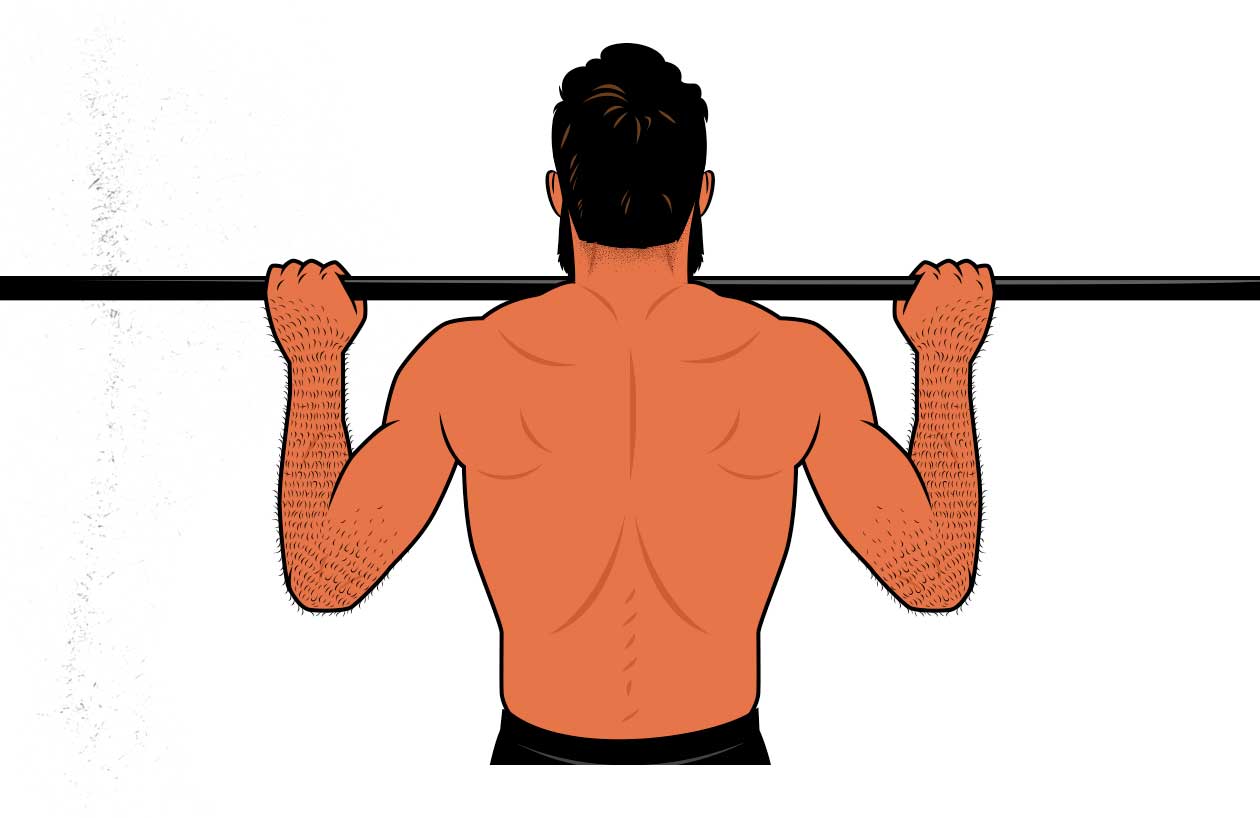
The advantage of pull-ups is that they work your lats just as hard as chin-ups, but with less work being done by your other muscles. So if you want a smaller assistance exercise that puts more emphasis on your lats than your biceps, pull-ups are great for that.
For more, we have a full article on chin-ups vs pull-ups, going over the differences in muscle activation and range of motion.
The Best Chin-Up Alternatives
We’ve already covered the best chin-up variations, including ones that are easier on our elbows and that emphasize different muscles. But sometimes people don’t have access to a chin-up bar. In that case, you can do rows, pullovers, and biceps curls. The row works many of the same upper back muscles as the chin-up, but the downside is that it doesn’t work our lats in a deep stretch, and it doesn’t do a very good job of challenging our biceps.
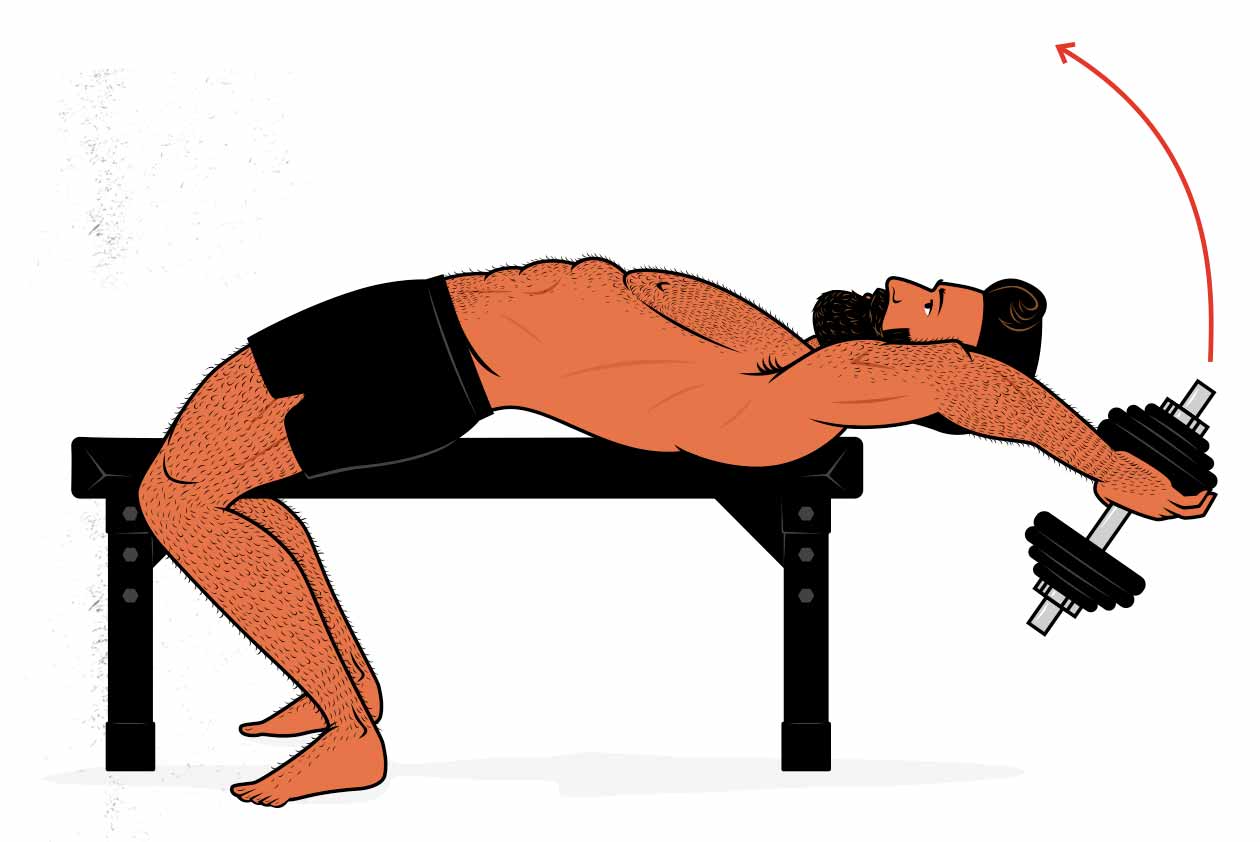
If we add in the pullover, we can challenge our lats in a deep stretch. And if we add in the biceps curl, we have an exercise that’s perfect for our biceps. So by combining the row, pullover, and curl, we have a combination of exercises that will help us fully develop our backs and biceps.
I realize that replacing a single exercise with three different exercises sounds like a pain, but keep in mind that even if you’re doing chin-ups, it still helps to be doing rows, pullovers, and curls. Variety is always a good thing.
How to Improve Your Chin-Ups
Using a Deep Range of Motion
To perform a chin-up, you start by hanging from the bar with arms fully extended, from what’s called a dead hang. Then you explode out of the bottom, pulling yourself up with all of your might, and bringing your chest all the way to the bar.
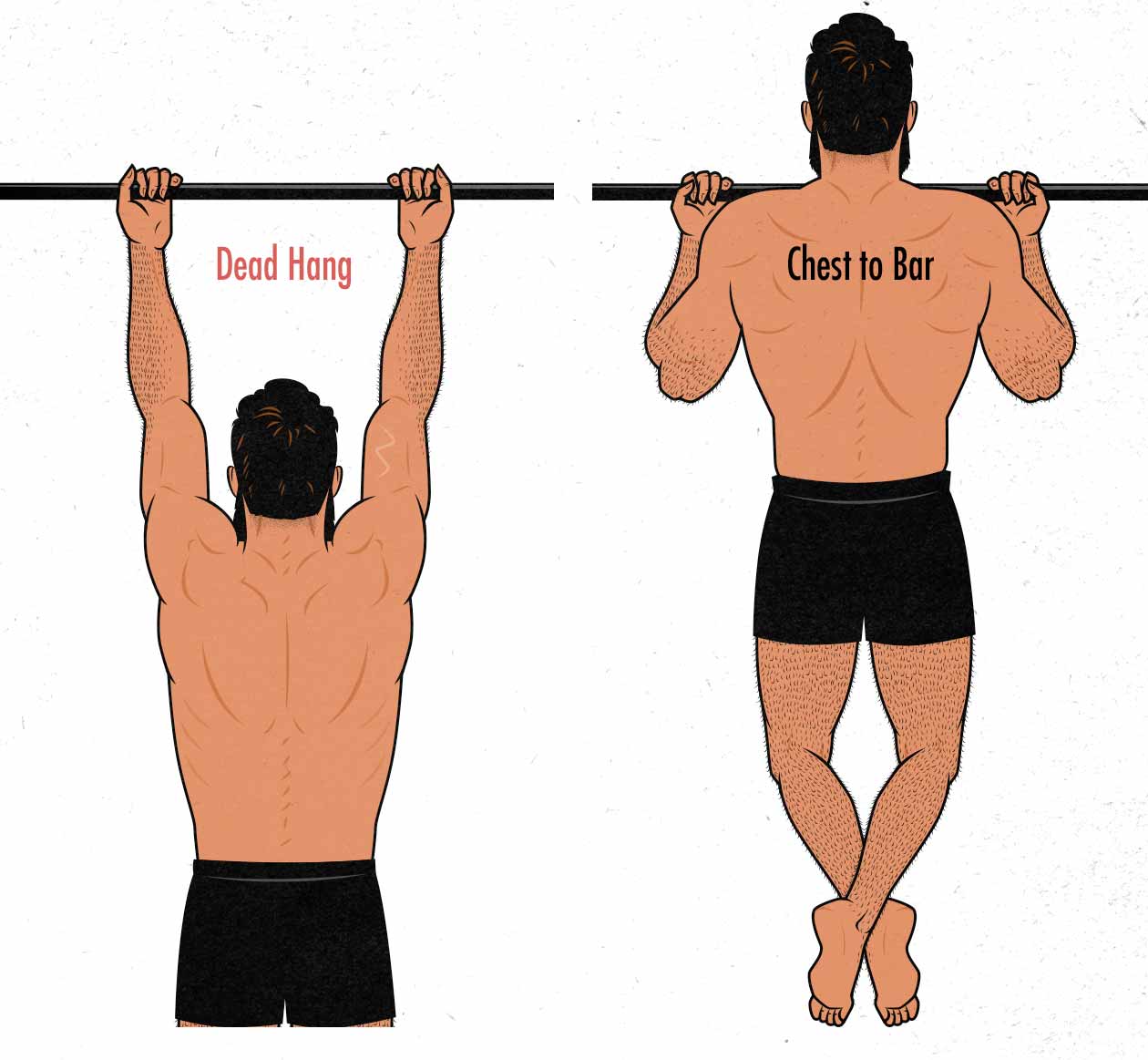
It’s not a small isolation movement where you focus on keeping tension on the muscles or feeling the burn. It’s more like an upper-body deadlift. You reset at the bottom, gather your energy, and bring every ounce of force that you can muster into pulling yourself up.
The purpose of starting from a dead hang and bringing your chest to the bar is that you want to use the largest range of motion that you can manage. As a general rule, using a larger range of motion will improve your mobility, develop a more versatile kind of strength, and, of course, stimulate more muscle growth.
Now, to be clear, doing chin-ups with the largest possible range of motion won’t necessarily benefit your lats or your biceps. We’re actually going beyond their functional range of motion. Your lats will benefit from part of the extended range of motion, your biceps will benefit from another part of it, but the main reason you want that massive range of motion is that you’ll work dozens of other muscles along the way. At the bottom of the lift you’re going to need to bring in entirely different muscles to get you out of the hole. To pull yourself into the bar, again, more muscles will need to assist.
However, we don’t want to be too strict about range of motion, either. We don’t want to stop our sets as soon as we can’t touch our chests to the bar. That would be stopping too soon—long before our lats and biceps have been fully exhausted. That brings us to the next section.
How to Improve the Strength Curve
The strength curve of a lift is how challenging it is at various parts of the range of motion. This is important because our muscles only grow when they’re challenged, so if some parts of the range of motion are too easy, they won’t stimulate any muscle growth.
Most barbell lifts have a fairly similar (bell-shaped) strength curve, but pulling movements fall into their own unique category. When you’re training your back, you might notice that it’s relatively easy to get the weight moving, but then the last few inches become incredibly difficult. This is most pronounced with pull-ups and barbell rows, but it applies to chin-ups as well.
This isn’t because you have a strength imbalance that needs fixing, it’s because, first, the moment arms on most pulling exercises are longest at the top of the lift instead of in the middle (like the front squat) or at the bottom (like the bench press). Second, our muscles are able to contract far harder at the bottom of the lift (in the stretched position) than they are at the top (as they move towards full contraction).
There’s something else happening here, too. The lats, which are the main muscle we use when pulling, can’t bring the arms behind the body, meaning that with a lift like a barbell row, our strongest muscles can’t help us touch the barbell to our chests. Now, in some ways, that’s a good thing. Needing to use different muscles over the course of a single lift is one of the benefits of lifting with a large range of motion. I mean, why not build an even wider variety of muscles with that extra range of motion, right? However, since our lats are our strongest pulling muscle, if we limit how much we can lift based on how much weight our smaller muscles lift, then we won’t ever be lifting enough weight to challenge our lats, and our lats won’t grow.
Furthermore, it’s that bottom part of the lift—when our lats and biceps are stretched and we’re starting to pull ourselves up—that we stimulate the most muscle growth. It’s the bottom part of the range of motion that’s the most important.
Of all the pulling movements, the chin-up has one of the better strength curves, but even so, it’s normal to struggle to bring our chests all the way to the bar, and we shouldn’t necessarily stop our sets when that happens. After all, this is a chin-up, not a chest-up. As long as our chin clears the bar, it counts. (The same is true when we’re testing our 1-rep max. If our chin clears the bar, we’re all good.)
To be clear, there’s nothing wrong with bringing our chests all the way to the bar. For most of our reps, that’s a great goal. In fact, if we’re trying to leave a couple of reps in reserve, we might indeed stop our sets when we can no longer touch our chests to the bar. We just need to be clear that not being able to bring our chests all the way to the bar doesn’t count as reaching failure yet.
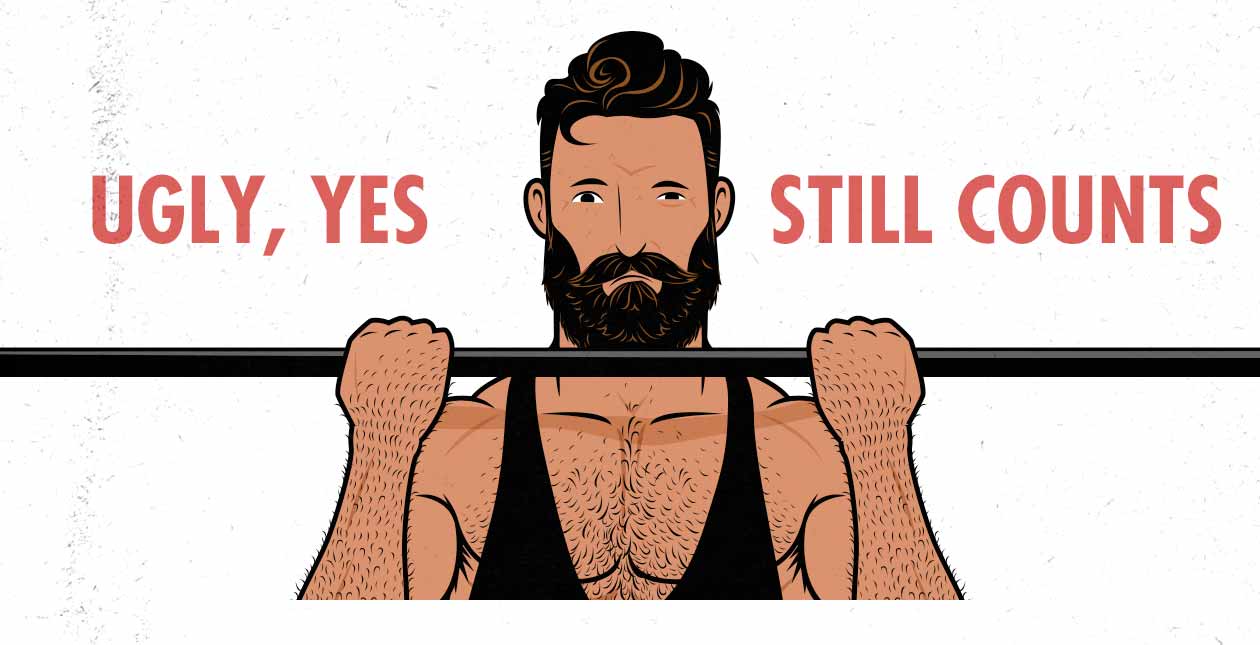
Point being, we should try to bring our chests all the way up to the bar when doing chin-ups, but we shouldn’t use that high standard to gauge whether we’ve reached failure. Failure is when we can no longer bring our chins all the way up to the bar. It is, after all, a chin-up.
Stretching Your Lats Between Sets
Recently, it’s been shown that stretching our muscles between sets may slightly increase muscle growth, perhaps by giving our muscles a bit of extra overall tension, and thus boosting our training volume a little higher (study). The research is still young, but so long as we aren’t stretching so painfully hard that we impair our strength, at worst it would have a neutral effect. Plus, since we’re stretching during our rest times, it won’t even increase the length of our workouts.
This technique, called interset stretching, involves stretching the prime movers of a lift for thirty seconds between sets to the point where we can feel a hearty but not painful stretch. If we stretch harder or longer, other research shows that it could start to impair our performance on subsequent sets, which would do more harm than good. We want to make sure that this stretching still allows us to lift just as heavy and hard as usual.
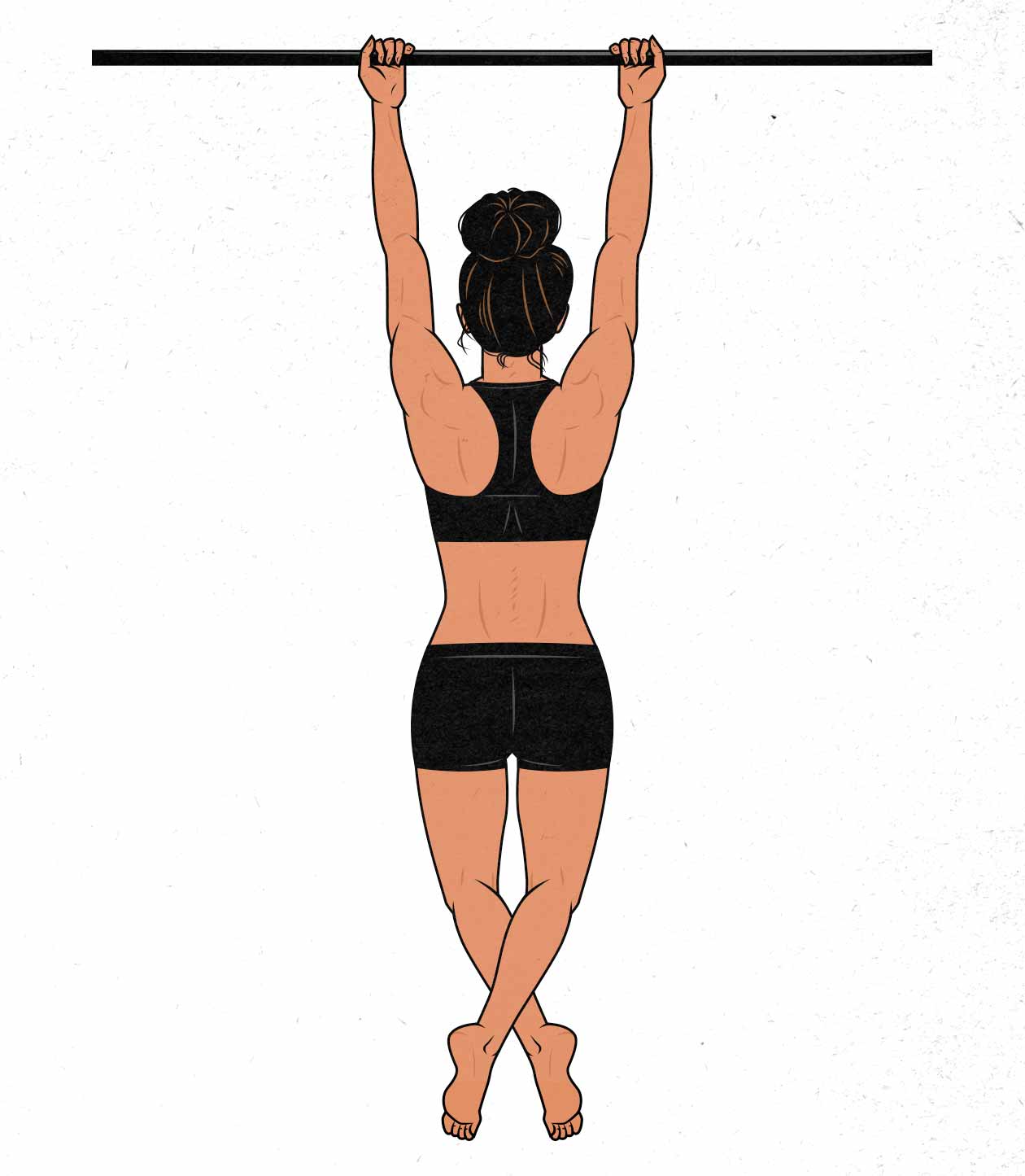
So in this case, what we want to do is stretch our lats between sets of pull-ups and perhaps barbell rows. Because our lats are often hard to bring close to failure during those back exercises, this can help give them a bit of extra stimulation, and so will likely give us some extra muscle growth.
Giving our lats a hearty but comfortable stretch for around thirty seconds between sets of chin-ups and rows could help boost muscle growth.
How to Do More Chin-Ups
As beginners, our strength on the chin-up is measured by how many bodyweight repetitions we can get. At first, we might only be able to do lowered chin-ups, or maybe grind out a couple hard reps. That’s when we’re focused on doing more chin-ups, adding more reps to each set we do.
There are a few ways we can work on that:
- We can do lowered chin-ups (a beginner variation). If you don’t have the strength to do full chin-ups, these will overload your muscles, stimulating quite a lot of muscle growth. These are especially valuable because they train the exact muscles that we need to do chin-ups. All of the strength you develop will improve your chin-ups.
- We can do exercises that work a similar movement pattern (assistance lifts), such as doing underhand lat pulldowns, band-assisted chin-ups, or using an assisted pull-up machine. These exercises aren’t quite the same as chin-ups, and they don’t work quite the same muscles, but there’s quite a lot of carryover. Most of the strength you gain will help you improve your chin-ups.
- We can do exercises that build muscle mass in the relevant muscles (accessory lifts), such as doing barbell curls for our biceps, pullovers for our lats, and barbell rows for our upper backs. Some of the strength you gain will improve your chin-ups.
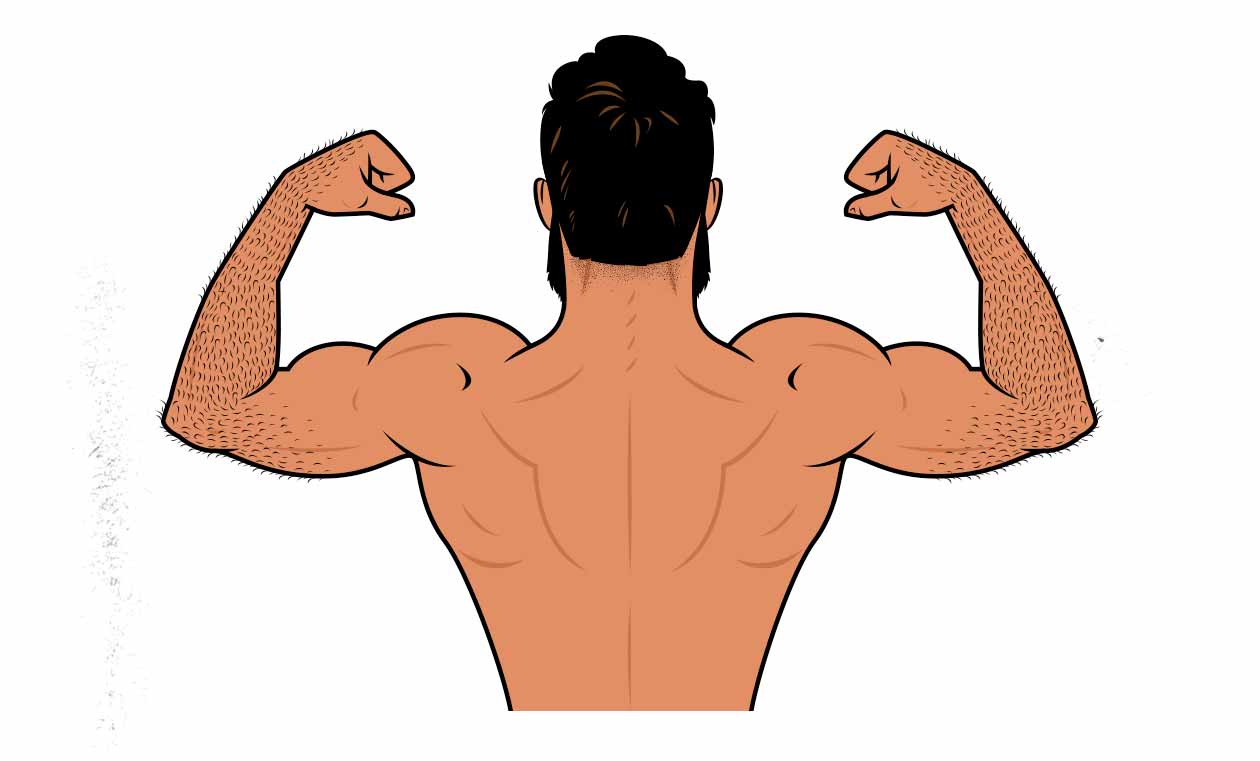
So as a beginner, we want to focus most of our attention on doing a beginner variation of the chin-up, since it has the best carryover to our chin-up performance. After that, we want to use some assistance lifts, such as lat pulldowns. And then we want to spend a bit of time bulking up the relevant muscles, such as by doing barbell curls and pullovers.
So maybe every week, you work the following exercises into your workout routine:
- Lowered chin-ups: 4 sets of as many repetitions as you can do. Maybe do these twice per week, giving you 8 total sets per week.
- Lat pulldowns: 3 sets of 8 reps. Perhaps do these twice per week, giving you 6 total sets per week.
- Barbell curls: 2 sets of 10 reps, done just once per week.
- Pullovers: 2 sets of 10 reps, done just once per week.
Over time, you’ll get stronger at the chin-up, your reps will start to climb. When you can do 6–12 reps, you can start adding weight to your chin-ups. You don’t have to ever add weight, but since chin-ups are quite taxing, it can help to do them for 6–12 reps so that your cardiovascular system doesn’t start to limit your performance.
How to Get Better at Chin-Ups
Once you’re able to do at least 6 chin-ups in a row, starting from a dead hang and bringing your chin over the bar, you’re past the beginner stage. Now it’s not about doing more chin-ups, it’s about doing heavier chin-ups. Now we’re trying to get stronger at the chin-up. This is when we buy a dip belt (like this one) or start holding dumbbells between our legs.
To get stronger at the chin-up, we want to take the same approach that a beginner would take.
- Main variations: the best way to get stronger at chin-ups is to do more chin-ups. So we prioritize chin-up variations (straight bar, neutral grip, gymnastics rings, and so on). These give us the most bang for our buck, and all of the muscle and strength we can will directly make us stronger at the chin-up. (And they’re amazing for building muscle.)
- Assistance lifts: after we’ve done our heavy chin-ups, we do some assistance lifts, such as pull-ups, lat pulldowns, and rows. These will make us stronger in a variety of similar movement patterns, and most of the muscle we build will improve our chin-up strength.
- Accessory lifts: we also want to hit the relevant muscles from different angles and make sure that we’re giving all of them a chance to get close enough to failure. In this case, we have the biceps curl for our biceps and the pullover for our lats.
You don’t need to do all of these lifts every time you do chin-ups. You can spread them out over the week. Maybe you do chin-ups and curls on Monday, rows on Wednesday, and pull-ups and pullovers on Friday. That way you’re stimulating your muscles 3 times per week, which is perfect for building muscle, and you’re adding up enough sets per week to maximize your rate of muscle growth.
There’s plenty of room for customization, though, especially as you get more and more advanced. Let’s go over the pros and cons of the assistance and accessory lifts so that you know how to choose the ones that are best for you.
The Best Assistance Lifts
The best assistance lifts for the chin-up are pulling lifts that work our back and biceps at the same time, such as underhand lat pulldowns. The movement is very similar, but it’s a lighter and easier variation that isn’t as fatiguing, allowing us to sneak in some extra volume. We can also use assistance lifts like the pull-up or row to work our upper backs and forearms.
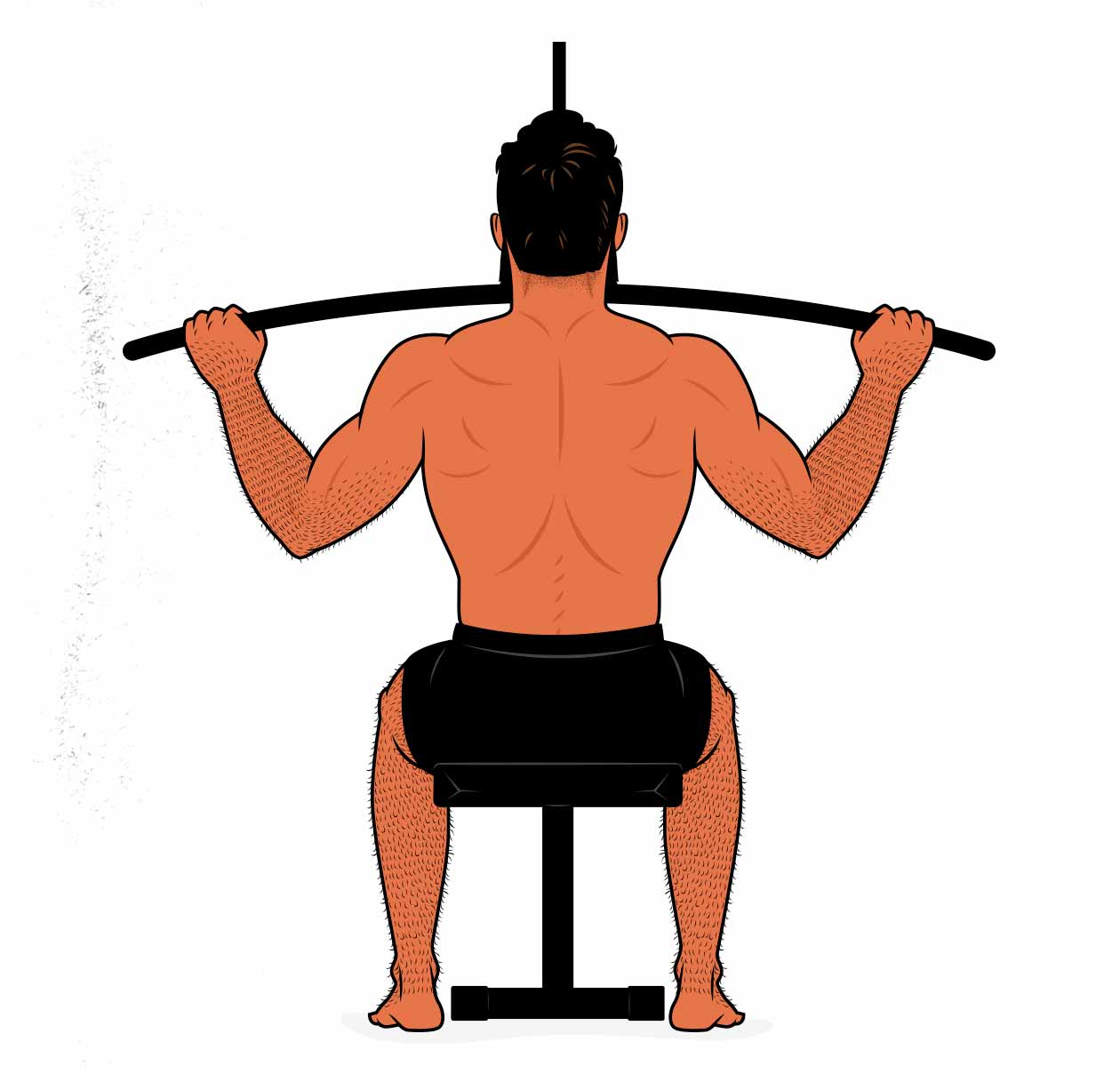
Here’s a more complete list of chin-up assistance lifts:
- Pull-Ups: using an overhand grip removes your biceps from the exercise, but still works your lats and forearms just as hard. This will force you to use lighter weight, making the pull-ups quite a bit easier to recover from. It’s a good assistance lift for guys with lagging lats.
- Underhand Lat Pulldowns: using an underhand grip while doing pulldowns is a great way to train the same muscles as the chin-up through the same range of motion, just with a lighter weight.
- 1-Arm Lat Pulldowns: you do these by attaching a one-handed grip to a lat pulldown machine. They’re absolutely fantastic for your biceps, lats, and rear delts. If you haven’t tried these yet, I highly recommend giving them a shot.
- Overhand Lat Pulldowns: these are great for emphasizing your lats and forearms, but keep in mind that the overhand grip won’t do a good job of engaging your biceps, and so you’ll need to use a lighter weight.
- Underhand Barbell Rows: if your lower back and spinal erectors aren’t overly fatigued from your deadlifting, these are a good assistance lift for both your chin-ups and deadlifts. Be careful about fatiguing your lower back, though. There’s only so much it can take.
- Dumbbell Rows: these are a fantastic lift for bulking up your lats and forearms. There are a bunch of different variations: 1-arm, 2-arm, chest-supported, with your hand resting on a bench, and so on. All of these variations are great, but the classic 1-arm dumbbell row with your hand on a bench is a good default.
- Chest-Supported Rows: If your lower back is already getting beaten up from your deadlift training, this is a great way to train your upper back without stressing your spinal erectors even more.
The Best Accessory Lifts
The best accessory lifts for the chin-up are the ones that work our biceps or lats under a deep stretch. For our biceps, barbell curls are great for engaging our upper backs and forearms, whereas incline curls work our biceps in an even deeper stretch. Both are fantastic. For our lats, we want to look at lifts like pullovers and straight-arm pulldowns. Both of those challenge our lats in a deep stretch with a great strength curve. These lifts don’t engage as much overall muscle mass as the chin-up, but they’re perfectly ideal for bulking up our lats and biceps one by one.
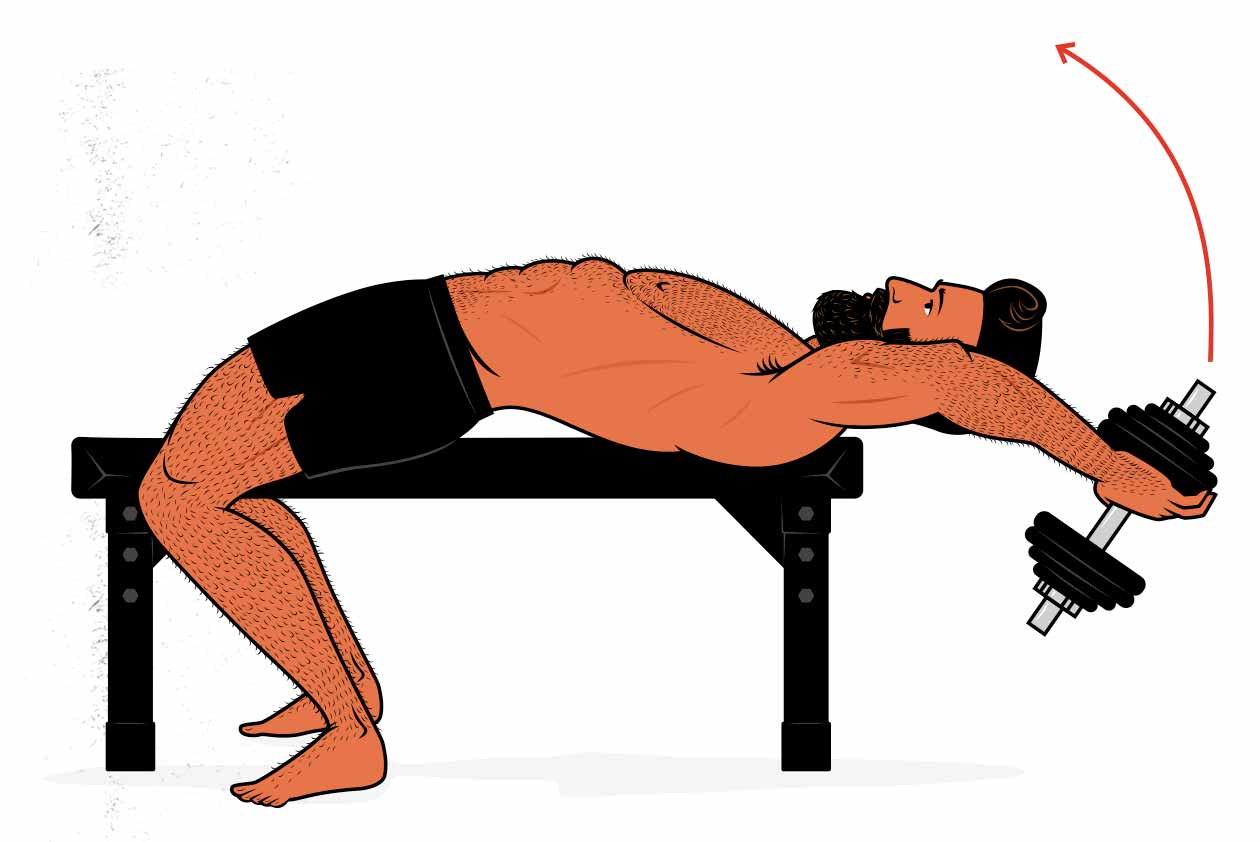
Here are more examples of chin-up accessory lifts, along with their pros and cons:
- Barbell and dumbell curls: biceps curls are a classic, no-brainer accessory lift for the chin-up. Your biceps are one of the main muscle groups being trained in the chin-up, and curls will do a great job of bulking them up. A lesser-known fact is that heavy biceps curls (especially with a barbell or curl-bar) are also great for your upper back, given that it needs to stabilize the weight.
- Lying biceps curls: this is a great exercise for challenging your biceps through a deeper range of motion. This seems to stimulate quite a bit more muscle growth per set.
- Preacher curls: preacher curls have the advantage of working our biceps harder in a stretched position, which seems to improve biceps growth by quite a lot. These are perhaps the best biceps isolation exercise. The downside is that they require a preacher curl bench, which brings us to …
- Power curls: power curls are similar to biceps curls, except instead of using strict form, you throw some hip drive in there. This will let you use heavier weights. The trick is to make sure that you’re contracting your biceps with full force all throughout the lift. Really try to accelerate that weight up. Then, to get the benefit of the heavier weight, lower the weight down under full control.
- Pullovers: pullovers are great for training both your lats and the long head of your triceps, which will help you pull your elbows to your torso while doing chin-ups. You can do these with dumbbells until you get so strong that you need to use a barbell or curl-bar. These challenge our lats in a stretched position, making them a great lat hypertrophy exercise.
Summary
The chin-up is perhaps the single best lift for bulking up our upper backs and biceps, and is one of the very best compound lifts for gaining overall muscle mass. There are many different ways of doing chin-ups, but the underhand chin-up is the heaviest variation that works the most overall muscle mass. The only variations that rival it are the neutral grip, angled grip, and gymnastics rings variations, all of which are similarly heavy and work the same muscles.
The pull-up is equally popular to the chin-up, but because it uses and overhand grip, it prevents our biceps from engaging. Because our biceps don’t engage, they don’t grow, and they also don’t help us lift more weight. So the pull-up becomes a smaller, more advanced lift. It’s still a great lift, but the chin-up is better for gaining overall muscle mass.
To get better at chin-ups, we want to focus most of our efforts on doing chin-ups themselves. (Or, if you can’t do 2–3 chin-ups yet, doing lowered chin-ups instead.) But we also want to use a wide variety of similar exercises, such as lat pulldowns and rows, and to work our muscles in different ways, such as with curls and pullovers. That’s how we build a balanced workout routine that will develop all of our muscles while making us stronger at the chin-up itself.
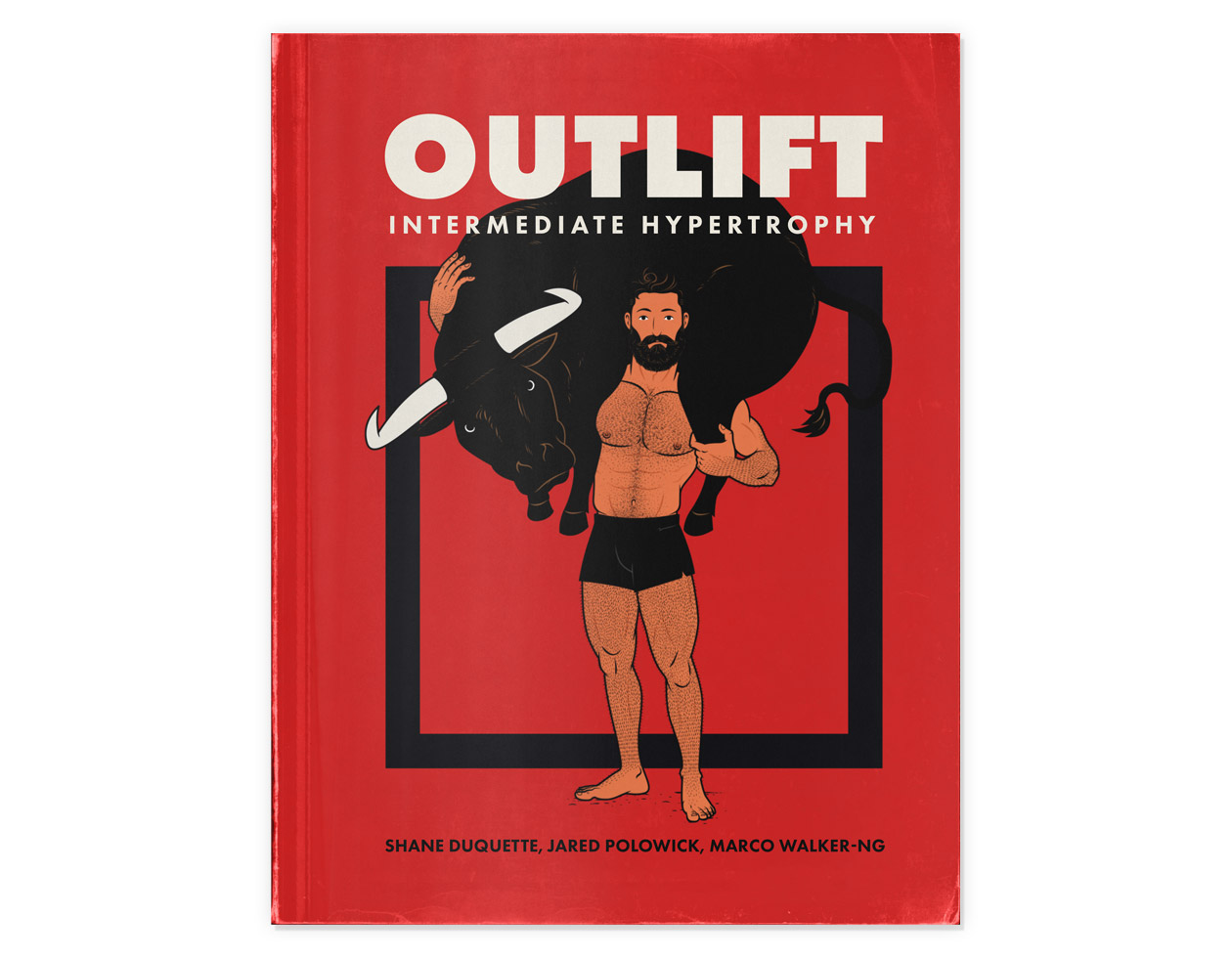
If you want a customizable workout program (and full guide) that builds these principles in, then check out our Outlift Intermediate Bulking Program. Or, if you’re still skinny or skinny-fat, try our Bony to Beastly (men’s) program or Bony to Bombshell (women’s) program. If you liked this article, you’ll love our full programs.



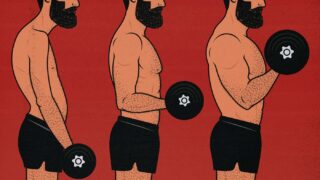
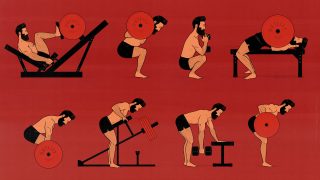
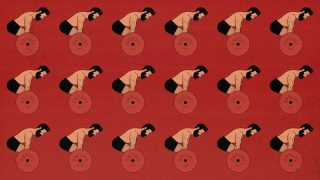
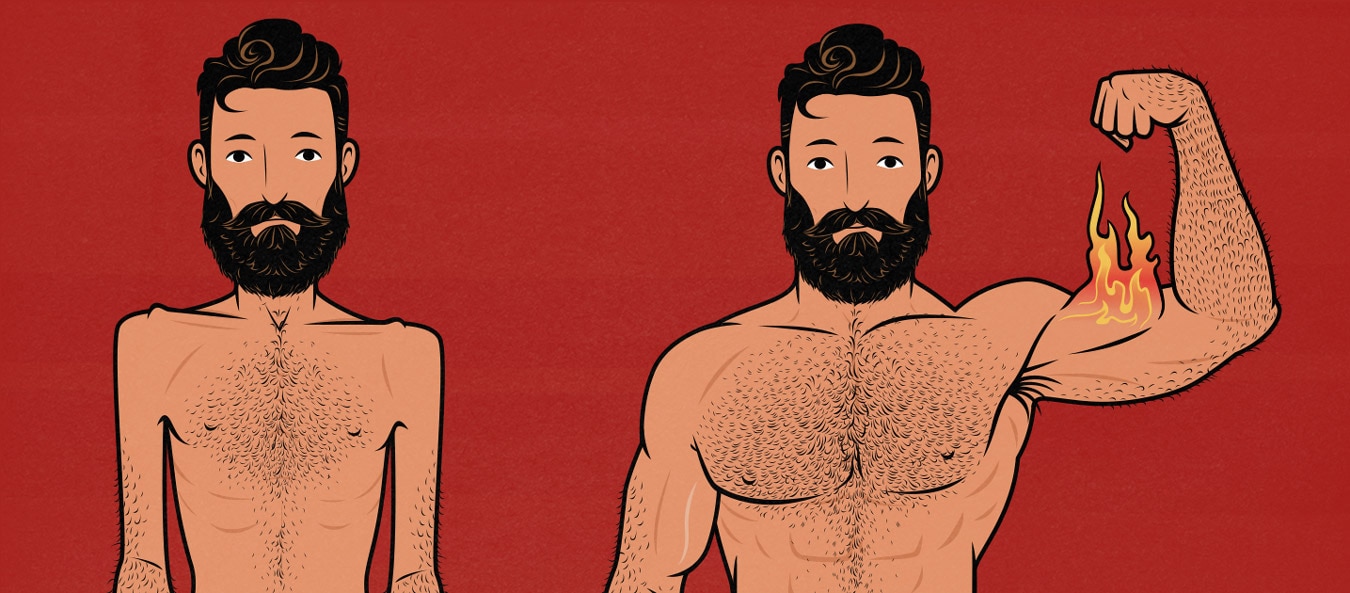
What is the best distance between the hands? Are close grip chin ups even better because they further increase the range of motion?
Gripping the bar about shoulder-width is a good default. With your arms hanging straight down, that would give you the largest range of motion. But you want to pick a grip width that you’re strong with and that feels good on your joints. If gripping the bar a little narrower or wider feels better or makes you stronger, go for it.
Also, feel free to vary your grip width from phase to phase. For example, you could spend a couple of months with a moderate grip, then switch to a super close grip, then switch to overhand pull-ups. That might help to ward off plateaus, it could lead to more balanced muscle growth, and it will vary the stress on your joints (giving them a better chance to adapt/recover).
Hi,I’ve been using a powertower and pull up bars at my gym for a few years now,but I’ve started to feel some strain in my forearms ,I perform wide grip,close grip and palms facing.do you think any of these could be straining my forearms?
Regards
Steve
Hm. It’s always hard to say with these multifactorial things. You could be right. It could be the chin-ups and chin-up variations, but it could also be a hundred other things. So you’ll need to kind of play around with it to see what works.
It’s common to get some elbow strain from chin-ups, especially when using a straight bar. When that happens, switching to a neutral grip or to gymnastics rings will often solve it. Now, I realize it’s not your elbows, it’s your forearms. But that might still be a good place to start: try using the angled or neutral grips.
Some other people find that the forearm pain goes away if they squeeze the bar tighter and keep it more in their palm, less in their fingers. In that case, it’s when the bar starts to pull out of their grip, and they’re holding it with the tips of their fingers—that’s when it starts to strain the forearms.
You could also ease back on the volume and leave an extra rep in reserve, see if simply taking it a bit easier allows you to recover and adapt from the strain.
And if the strain is currently in the process of adding up, getting worse with every session, maybe deload for a week to clear the stress, and then ease back into those movements (or alternatives) more gradually, starting with fewer sets and stopping further away from failure.
I do pull-ups along the bar parallel, moving from side to side. First right hand in front, then after 10 swap to left in front, trying to touch my shoulder against the bar. It’s great for the core as well. I use this as a variation to stop any boredom.
Variations like that can definitely be helpful and it’s a nice way to mix things up. Offset pull-ups can be good, too, where you pull towards just one arm at a time. The problem with moving along the bar with all of your muscles contracted is that you’d be training at very short muscle lengths, with your muscles fully contracted. When doing isometrics like that, you’ll build more muscle doing them at longer muscle lengths, with your muscles in a stretched position, as explained in our range of motion article.
If it were me, I’d do offset pull-ups and chin-ups through a full range of motion instead.
Hi Shane,
Just wondering what you might recommend as an alternative for performing a chin-up or pull-up from home without the bar. I currently don’t have one but would like to do some type of variation while I wait in the meantime with retail shipping being under pandemic delay, not to mention backorders.
Many thanks!
W.
Hey Winston, you might like our article on bodyweight hypertrophy training. There’s no great alternative to the chin-up that you can do without any equipment, but the best might be an inverted row using the underside of a table, as explained in that article. Not quite the same as a chin-up, but you’ll still be able to build your back that way.
If you have weights but not a chin-up bar, then other row variations would do the trick. Barbell and dumbbell rows. Pullovers can work well, too. Again, not quite the same as a chin-up, but you’ll be able to build a big back that way just fine 🙂
Thanks for the quick feedback, Shane; that at least gives me a starting point. I read through the article on hypertrophy training and with regards to reps, if I did a set that included say, the push-up, vertical push-up, squat, chin-up, and deadlift, would 3 sets of 8 repetitions be a good starting point, or should I do 3 sets of as many reps as I can get in as close to failure as possible? : )
W.
You always want to bring your sets within 0–3 reps of failure, and when doing bodyweight training, it’s usually helpful to push it even harder, especially if the rep ranges are higher. So, no, don’t cap it at 8 reps. Do as many reps as you can for each exercise, stopping just shy of failure.
Thanks again Shane for the clarification! You do a really great job at keeping up with all of these blog questions, so hats off to you!
For a beginner who is trying to bulk, it seems the logic here is that it is best to start with BODYWEIGHT hypertrophy before moving to FREE-WEIGHT hypertrophy training. Am I understanding that correctly from the articles?
Coupled with stopping just shy of failure, will one naturally realize that it’s time to add weights when it takes longer and longer to reach just shy of failure? Now I’m wondering, is there any harm in doing both BODYWEIGHT + FREE-WEIGHT exercises simultaneously when starting out, or are they most effectively done in tandem?
My pleasure, man! 🙂
No, no, beginners don’t need to start with bodyweight training. It’s more complicated and painful than free weights, so if you have access to lifting equipment, I’d definitely take advantage of it right from the very beginning. Free weights are popular for a reason. They really do make it simpler and more pleasant to build muscle. It’s just that not everyone has access to free weights. In that case, starting with bodyweight training is perfectly fine. It hurts and it’s a bit more finicky, yes, but it still yields comparable muscle growth, making it a totally valid option.
If you have free weights, you can still do the better bodyweight exercises, yeah. Push-ups and chin-ups are great even when you’re training at a fully stocked gym.
As for increasing the weight, if you have free weights that you can add weight to, you can add weight whenever you’re able to hit your rep goal. If your program says 3 sets of 10 repetitions, you can add weight whenever you can do 10 repetitions for all 3 sets. If you can’t add weight, try to add reps. If the reps get painfully high (or they’re above 40 reps), use a more difficult variation.
Hey Shane, I am a seventeen teenage girl who wants to build muscle, get curvier and stronger. I’ve been doing cardio and a few bodyweight exercises in the last months while aiming for weight loss. I would appreciate if you inform me about where to start my journey as a female beginner on strength training and some tips to stay as lean as possible.
Hey Douae,
We’ve written a few articles going over the basics of bulking for women, such as our beginner muscle-building workout guide for women and our beginner bulking diet guide for women.
And if you want a program to walk you through the entire process of leanly building muscle, getting stronger, and becoming curvier, that’s what our Bony to Bombshell Program is for. It includes a 5-month workout program, tutorial videos teaching all of the lifts, everything you need to know about nutrition, recipes to make the diet easier, and much more.
Hi Shane, superb article I’ve been looking for something like this. One question on chinup. It’s said that the bottom half of the movement activates lats most – so for those lacking lat development, is it ok to cut the range of motion and focus only on bottom half?
Hey Alfa, thank you! Glad you liked it 🙂
Yeah, your idea makes sense.
We tend to stimulate the most muscle growth near the sticking point of the lift, where our muscles are challenged the most. Ideally, that sticking point is when our muscles are in a stretched position. A good example of that is on the bench press, where our chests get a deep stretch at the bottom, which is also right near our sticking point.
For the chin-up, the sticking point tends to be at the top of the range of motion. If we cut away the top—the hardest part of the lift—as we’re moving the sticking point deeper into the range of motion, and probably allowing us to lift more weight or get more reps. So, yeah, that could be better for challenging the lats in a stretched position.
But there’s a way to get the best of both worlds. We could do our chin-ups with a full range of motion—chest to bar—for as many reps as we’re able, and then when we stop being able to pull ourselves all the way up, we keep going until we can’t bring our chins to the bar, say. If you wanted to exaggerate that, you could keep doing them until you can’t bring your forehead to the bar. That way you’re turning your lats into more of a limiting factor.
If chin-ups aren’t hitting your lats, it might not be the range of motion that’s the problem, though. You might have better luck by finessing your technique. In this case, instead of pulling with your hands, think of pulling through your elbows, driving them down to your hips. That’s the movement that trains the lats. Getting better at that movement often helps to correct the lagging lat issue.
For more, you might dig our article on range of motion.
I’m dead after 5 rep,what can i do to improve my strength?
Keep trying to fight for more reps every workout, do more sets, do chin-ups more often, or consider adding some extra assistance and accessory work: lat pulldowns, biceps curls, rows, pullovers, and so on. Gaining weight and muscle mass will also help (although it will also mean you have you to lift a heavier body!).
Great articles, thanks. It so great to see advice from a source that seems to know what they are talking about. I’m 70 in a few months but when the gyms closed I bought a chin up/dip rack to stay in shape. I’ve been working out 3 days a week for about 60 minutes and I alternate chin-ups (8 sets of 11)(last set is 20) and pull-ups (8 sets of 7)(last set is 15). I was doing more reps but then I realized that my range of motion was a bit short so I reduced reps and increased range of motion. I never really thought about touching my chest so after reading your article I tried that. For me, even if I pull up to where my arms lock out I don’t touch my chest. Probably just need to build my chest more. Need to figure how to do that without a proper bench or heavy bar weight. I do both decline and standard push ups but it takes a lot of those for me to get to failure and I’m trying to keep my workout time down. I try to promote that achieving good health does not need to dominate our lives
I am a wellness consultant and I will definite refer clients to your sight when the need arises for them. I focus mostly on mind set and what to eat and NOT eat so you are a great resource for me.
Thanks again
That’s awesome, Charles. And thank you! 🙂
This article confirms what I’ve been thinking for a long time now, that the Chin-up is the superior movement. Since we know that compound movements are better than isolation ones, it’s only logical to assume that a compound movement that engages more muscle groups will be better than the one that engages less. Whatever meagre advantage the Pull up holds for lat development is completely erased once we add weight to the Chin up, and of course the biceps are much, much better stimulated compared to the Pull up. The Chin up will always give better development across the board when progressively overloaded.
You guys seem like the real deal, people of knowledge and common sense, unlike many so called experts that don’t have the slightest idea what thye’re talking about. Thank you for the article.
That’s a great summary, yeah. And thank you, Sam 🙂
Hi Shane, been reading your articles recently and I found this as I was finding out how I could hit overcome a plateau with my weighted chin.
Hammer grip weighted pull up with 30kg (bw 80kg) for 4 reps – been doing a RPT training style. I have now been stuck for 3 months now.
I started to increase my rows, rear delt and bicep training as assistance but it did not seem to help. Took some time off, swapped over to ring chin up for a while as well. Wanted to get your input on this!
Hey Joel,
It’s a good idea to use those other back and biceps lifts as accessory and assistance lifts, and they should help your chin-up in a roundabout way, but they may not be quite similar enough to the chin-up to get you past your plateau.
When you say reverse pyramid training (RPT), you mean that those 4-rep sets are your heaviest set, right? And then you do, say, a set of 6 reps and then 8 reps? That’s fairly low volume on the chin-ups. If you’re stuck on a low-volume routine, a good first step is simply to raise the training volume a little bit. Maybe do 4, 6, 8, 8 instead. That extra moderate-rep set will stimulate more growth in your biceps and upper back.
In addition to doing more sets per workout, we can look at how many workouts per week you’re doing. If you’re only doing chin-ups once per week, try doing them 2–3 times per week.
The next thing to consider is how you’re progressing. If you’re trying to go from 4 reps up to 5 reps, that requires a fairly significant increase in strength. It might be easier to add a kilo to your weight belt every week or two.
We also need to make sure that your diet is allowing you to gain muscle. Are you gaining weight? Are your muscles getting bigger? If you aren’t gaining weight, maybe try eating more calories so that you can start building muscle. If you ARE gaining weight, though, keep in mind that for every kilo you gain, that’s another kilo you’re lifting. If you’re maintaining your reps while gaining weight, that’s at least a bit of progress.
And then, yeah, assistance and accessory work. Think of underhand and hammer-grip pulldowns, pullovers, hammer-grip/underhand rows, and so on. Biceps curls are always a good idea, too, but it might be your lats holding you back, so having some of those lat-dominant lifts in your routine should help.
I hope that helps!
Thank you so much for the detailed reply! Will be breaking it down and applying it.
Your site has been popping up on google search for fitness related information. Your SEO strategy is working 🙂
I was reading another article of yours. I learnt that a bigger muscle has a larger potential for strength. On that note, would you suggest having separate workouts or weeks focusing on intensity and volume?
My pleasure, Joel!
Yeah, the bigger a muscle is, the stronger it is. The greater the cross-sectional area, the greater its ability to generate force. So the bigger you can build your muscles, the stronger you’ll be. However, if you want to increase your 1-rep max on specific lifts, that means training for those specific skills—training in lower rep ranges on those specific lifts. So, for instance, there’s more to powerlifting than just building big muscles, you also need to train for the sport of powerlifting.
There are a few different definitions of intensity, but I’m thinking you mean lower rep ranges? Like, a workout where you do sets of 5 reps, another workout where you do sets of 10 reps? You could! There are many different ways of periodizing a program. You could spend a few weeks in moderate rep ranges and do more volume, then a few weeks in lower rep ranges going heavier. Or you could do a moderate and heavy workout each week. Or you could do both moderate and heavy sets each workout (as in reverse pyramid training). There are a lot of options for that, and they all work fairly well. (We should probably write a full article on it, too.)
I got back into lifting with a home gym, focusing on upper body. I love your “Big 5 compound lifts” (and the research!). Thanks for making some really solid content and putting it out there.
I’m a 6 ft 185 lb male and after lots of 3×5 Starting Strength and 5×5 Stronglifts and planning to do RPE at some point, to start off easy I decided on 3 sets of 15 reps (so I feel accomplished and getting more of a bodybuilding result, plus necessitating lighter weight so, to me, easier control and ergo lower risk of injury (granted, that’s debatable)).
I found your site trying to answer “lowered chin-ups” (aka let down chin-ups) versus barbell rows for increasing chin-ups reps, and was happily surprised to see all the praise for chin-ups. My max ever has been 12 chin-ups in one set and right now, with 1 minute breaks, my three sets end up at 7, 5, and 2 reps. I decided I needed to do something rather than skipping my missed reps.
I’m still learning lowered chin-ups but they seem quite complicated. It’s easy to hold at the top, but then descending goes very quickly and I don’t feel like I’m getting much out of it. Really difficult to “control”, you know? I’m not sure if I should hold for 3-5 seconds then descend at a not-so-slow speed or try to make the hold plus the descent last a total of 5 seconds. Again, it’s so much easier to hold at the top for 5 seconds and when I’m tired (which happens fast on these, the reflex is to cheat).
Is 3×15 unreasonable? Should I somehow do weighted lowered chin-ups? Or is there some trick or resource for lowered chin-ups I’m missing? What are the best specifics for where to engage muscles and seconds for how long for holding at the top versus how long to descend, for say the overall rep goal? How many reps is really unreasonable?
Side question: Any thoughts on keeping the knees tucked up for extra ab engagement during chin-ups? I find it really difficult and possibly a useless distraction, but it seems like a good opportunity to get some ab work in also.
Thanks again for all the resources. I plan to checkout the Outlift Intermediate program once I’m back to respectable weights on your recommended “big 5 compound lifts”.
Hey Will, sorry for missing this comment. Thank you so much for the kind words!
You’re right that doing 2 reps on your final set isn’t adding much volume, and so there’s a problem there. The reason you’re hemorrhaging reps between sets is because your rest times are so short. 1-minute rest periods for chin-ups isn’t enough. I’d rest 2–5 minutes to preserve most of your strength from set to set. If you can do 7 reps, try for 6,6,6. Or maybe 6,6,5. Something along those lines. If 2 minutes isn’t enough, rest 3 minutes. Or 4, or 5.
I’m guessing you might not want to spend all of that time resting, but if that’s the case, you could squeeze in another exercise that doesn’t work the same muscles. Maybe do your front squats, rest 1–2 minutes, do your chin-ups, rest 1–2 minutes, do your front squats, and so on. That kind of thing. That way your chin-up muscles get plenty of rest between sets.
Lowered chin-ups are good for developing the strength needed to do chin-ups, but if you can do 7–12 chin-ups, you don’t need them anymore. Better to focus on doing full chin-ups.
3×15 is a great rep scheme, but if you can’t do 15 chin-ups, yeah, it’s unreasonable. In your case, doing 3xAMRAP (as many reps as possible) is better.
Chin-ups are pretty good for the abs even if you just keep your torso held rigid and straight. There’s no problem with raising your knees, but keep in mind that combo exercises often don’t work very well because some of the muscles aren’t brought close enough to failure. So, for example, let’s say that you could hold your knees up for 60 seconds, but you finish your set of chin-ups in 30 seconds. That might be “hard” on your abs, but it’s not hard enough to stimulate muscle growth. You’ve made the exercise harder but with no real benefit. That’s why it’s often better to do one lift and then the other. So do your chin-ups and then do a couple sets of hanging leg raises after.
Hi Shane, Thanks so much for that great advice.
Since that post, I’ve been working out every other day with neutral grip chin-ups and 2-minute breaks. I kind of plateaued, and I wanted to get your thoughts. I do 10 repetitions (without trying for more) for the first of three sets, 7 (without trying for more) for the second of three sets, and then as many reps as I can for the third of three sets. I got up to 9 reps on the third set, but it hovers between 7, 8, and 9 (depending on the day). So today I tried for as many as I could, and did 12, 7, and 4 reps.
What I’m really curious about is and want to get input on are two things, which are:
A) Is it better to do more reps in earlier or later sets?
B) Is it better to stick to round numbers without trying for as many reps as I can get on some sets, or should I always do as many reps as I can?
1. 10 (don’t try), 10 (don’t try), 4 (try)
2. 8 (don’t try), 8 (don’t try), 9 (try)
3. 12 (try), 7 (try), 4 (try)
4. 12 (try), 5 (don’t try), 5 (don’t try)
Should I try to get the most reps on the last set (1), or keep them as even as possible (2), or just go all out on all sets (3), or do as many as I can on the first set but keep the others to a given number for a while (4)?
Thanks for all the great info on all the new posts also.
Hey Will, good question.
The ideal way to lift weights as an intermediate lifter is usually to stop 1–2 reps shy of failure on most of your sets. For instance, with your chin-ups, that might mean stopping 2 reps shy of failure on your first set, 1 rep shy of failure on your second, and doing as many reps as you can on your third set. So what you’ve been doing is good, but as you get stronger, the goal is to either get more reps or add more weight, so aim to be improving on those first two sets, too.
If you’re making improvements on your other lifts but not your chin-ups, then you’ve hit a specific plateau with your chin-ups, not a plateau overall. That tells us that you’re probably eating enough food, enough protein, and getting enough rest, we just need to get more stimulation out of your chin-ups. You might want to try doing an extra set each workout to sneak in some extra volume. (Also remember to take an easy week every now and then to give yourself a chance to fully recover.)
If all of your lifts are plateaued, the problem might not be your chin-up training, just that you need to improve your ability to build muscle overall. Think about eating more calories, gaining more weight, eating more protein, and getting more sleep.
I hope that helps!
Hey Shane, so let’s say I’m doing weighted chin-ups with 20LBs to failure on every set, on the first set I get 9, then 7, and finally 5 reps
For progressive overload, I should aim to get 9,7,6 the next workout?
And once I can finally hit 10-12 reps for 3 sets I should up the weight a bit?
Also, I’ve noticed on some sets, especially when aiming for complete failure, that on the last rep I can pull myself up halfway relatively fine however, on the top portion I’m pulling with all my force but still can’t get my chin over the bar, would this be considered failure?
Yep! That’s exactly right. You could aim for 9,7,6 if you want. Or you could approach each set individually, trying for 10 reps in the first set, and then seeing what you’re able to get in the subsequent sets. As long as you’re pushing yourself within a couple reps of failure, and as long as you’re trying to improve in some way, you’ll do a great job of gaining muscle and strength.
You can up the weight whenever you get a certain number of reps in the first set OR the last set. Maybe you increase the weight when you get 12 reps in the first set. Or maybe you increase the weight when you get 10 reps in the third set. Both ways of adding weight are perfectly fine. Both will keep you well within the ideal rep range (of around 6–20 reps). The ideal rep range is pretty loose, too. Nothing wrong with 5 or 25 reps, if you prefer it. Totally up to you.
Back exercises are funny. The top part of the lift is the hardest. That’s the part that gives out first. When you can’t bring your chest to the bar, that could be seen as a sort of failure. When you can’t bring your chin above the bar, most people wouldn’t call it a “chin-up” anymore. When you can’t even do the bottom half of the lift, you’ve hit an even deeper sort of failure. Maybe you save that deepest sort of failure for your final set. That way you feel a bit fresher on those earlier sets.